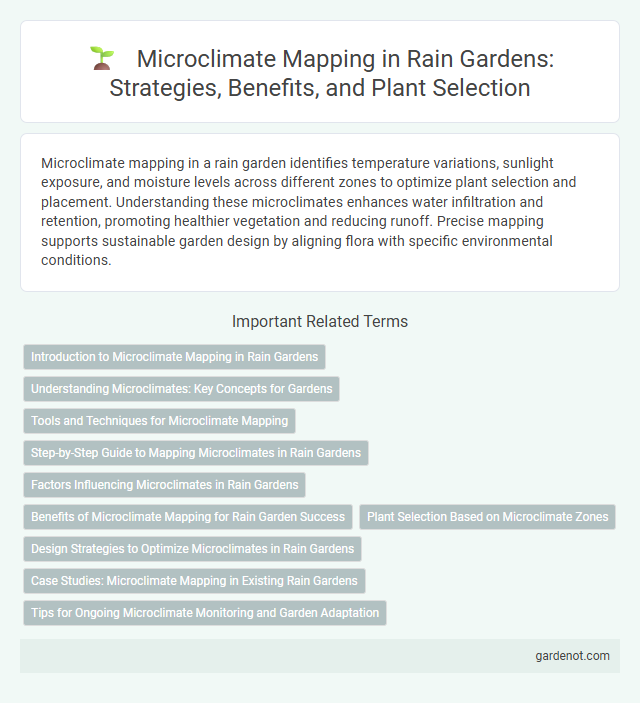Microclimate mapping in a rain garden identifies temperature variations, sunlight exposure, and moisture levels across different zones to optimize plant selection and placement. Understanding these microclimates enhances water infiltration and retention, promoting healthier vegetation and reducing runoff. Precise mapping supports sustainable garden design by aligning flora with specific environmental conditions.
Introduction to Microclimate Mapping in Rain Gardens
Microclimate mapping in rain gardens involves analyzing localized environmental factors such as temperature, humidity, sunlight, and wind patterns to optimize plant selection and placement. This technique helps improve water absorption, reduce heat islands, and enhance biodiversity by creating favorable growing conditions within the rain garden. Using tools like GIS and sensor networks allows for precise data collection, informing sustainable rain garden design and management.
Understanding Microclimates: Key Concepts for Gardens
Microclimate mapping in rain gardens involves analyzing localized temperature, humidity, sunlight, and wind patterns to optimize plant selection and placement. Key concepts include identifying shade and sun exposure, soil moisture variation, and airflow to create a balanced environment that supports diverse plant species and improves water infiltration. Understanding these microclimates enhances garden resilience, promotes biodiversity, and maximizes ecological benefits in urban landscapes.
Tools and Techniques for Microclimate Mapping
Microclimate mapping for rain gardens utilizes tools such as GIS (Geographic Information Systems), remote sensing, and data loggers to analyze temperature, humidity, and sunlight patterns with high spatial resolution. Techniques involve collecting real-time environmental data to identify microclimatic variations that influence rain garden performance, including evapotranspiration rates and soil moisture levels. Advanced modeling software integrates these datasets to optimize rain garden design for improved stormwater management and ecological benefits.
Step-by-Step Guide to Mapping Microclimates in Rain Gardens
Mapping microclimates in rain gardens involves systematically analyzing sunlight exposure, soil moisture, and wind patterns to identify distinct environmental zones. Use tools like soil moisture sensors, light meters, and anemometers to record data at various points throughout the garden at different times of the day and year. This detailed data collection allows for optimized plant placement based on specific microclimatic conditions, enhancing rain garden performance and biodiversity.
Factors Influencing Microclimates in Rain Gardens
Microclimate mapping in rain gardens reveals critical factors influencing localized climate conditions, such as soil moisture levels, plant species diversity, and shading intensity from surrounding vegetation. Soil composition and permeability directly affect water retention and evaporation rates, altering temperature and humidity within the garden. Additionally, the spatial arrangement of native plants and mulching techniques contributes to moderating temperature extremes and improving microhabitat quality for beneficial organisms.
Benefits of Microclimate Mapping for Rain Garden Success
Microclimate mapping enhances rain garden success by identifying specific environmental conditions such as sunlight exposure, soil moisture, and wind patterns to optimize plant selection and placement. This targeted approach increases water absorption efficiency, reduces runoff, and promotes healthier plant growth. Understanding microclimate variations also helps prevent erosion and supports biodiversity within urban water management systems.
Plant Selection Based on Microclimate Zones
Selecting plants for rain gardens requires detailed microclimate mapping to identify zones with varying sunlight, moisture, and temperature levels. Native species adapted to specific microclimate conditions enhance rain garden performance by maximizing water absorption and promoting biodiversity. Effective plant selection based on microclimate zones improves resilience to environmental stress and supports local ecosystems.
Design Strategies to Optimize Microclimates in Rain Gardens
Design strategies to optimize microclimates in rain gardens include selecting native plants with varied canopy structures to regulate temperature and humidity effectively. Incorporating permeable surfaces and strategically placed vegetation enhances airflow and soil moisture retention, creating favorable microhabitats. Utilizing topographic variations and shading elements controls sunlight exposure, promoting biodiversity and improving stormwater management efficiency.
Case Studies: Microclimate Mapping in Existing Rain Gardens
Case studies of microclimate mapping in existing rain gardens reveal localized temperature reductions of up to 3degC, enhancing urban heat mitigation. Sensor networks capturing data on humidity, solar radiation, and wind patterns demonstrate variations influenced by plant selection and garden design. These insights guide optimized rain garden placement, maximizing cooling benefits and stormwater management efficiency.
Tips for Ongoing Microclimate Monitoring and Garden Adaptation
Regularly monitor temperature, humidity, and soil moisture levels using handheld sensors and wireless data loggers to detect subtle changes in microclimate variables around the rain garden. Record data seasonally to identify patterns in sunlight exposure and wind flow, enabling targeted adjustments to plant selection and garden layout for optimal growth. Implement shading structures or windbreaks based on microclimate data to enhance plant resilience and maintain effective stormwater management.
Microclimate mapping Infographic

 gardenot.com
gardenot.com